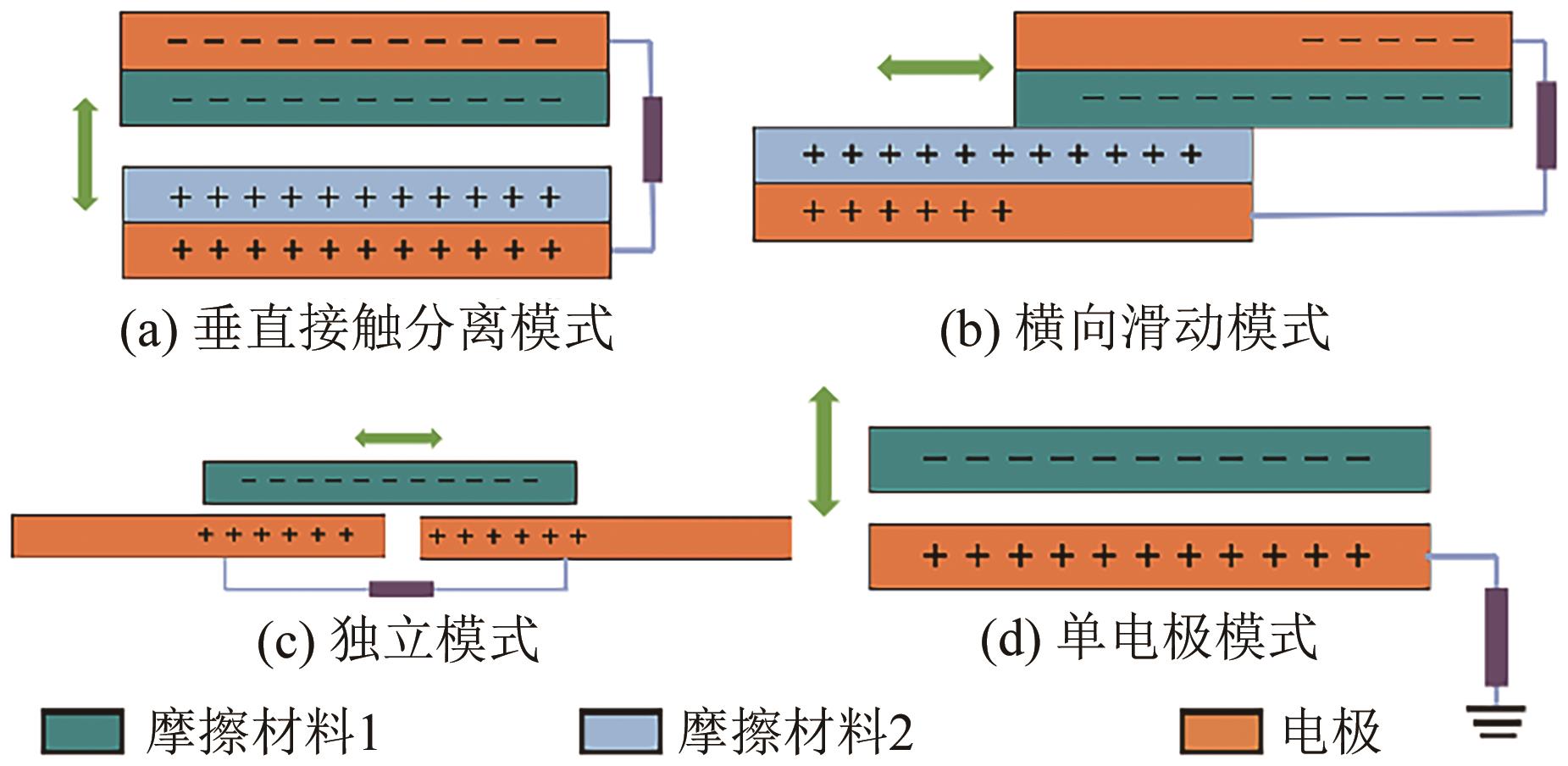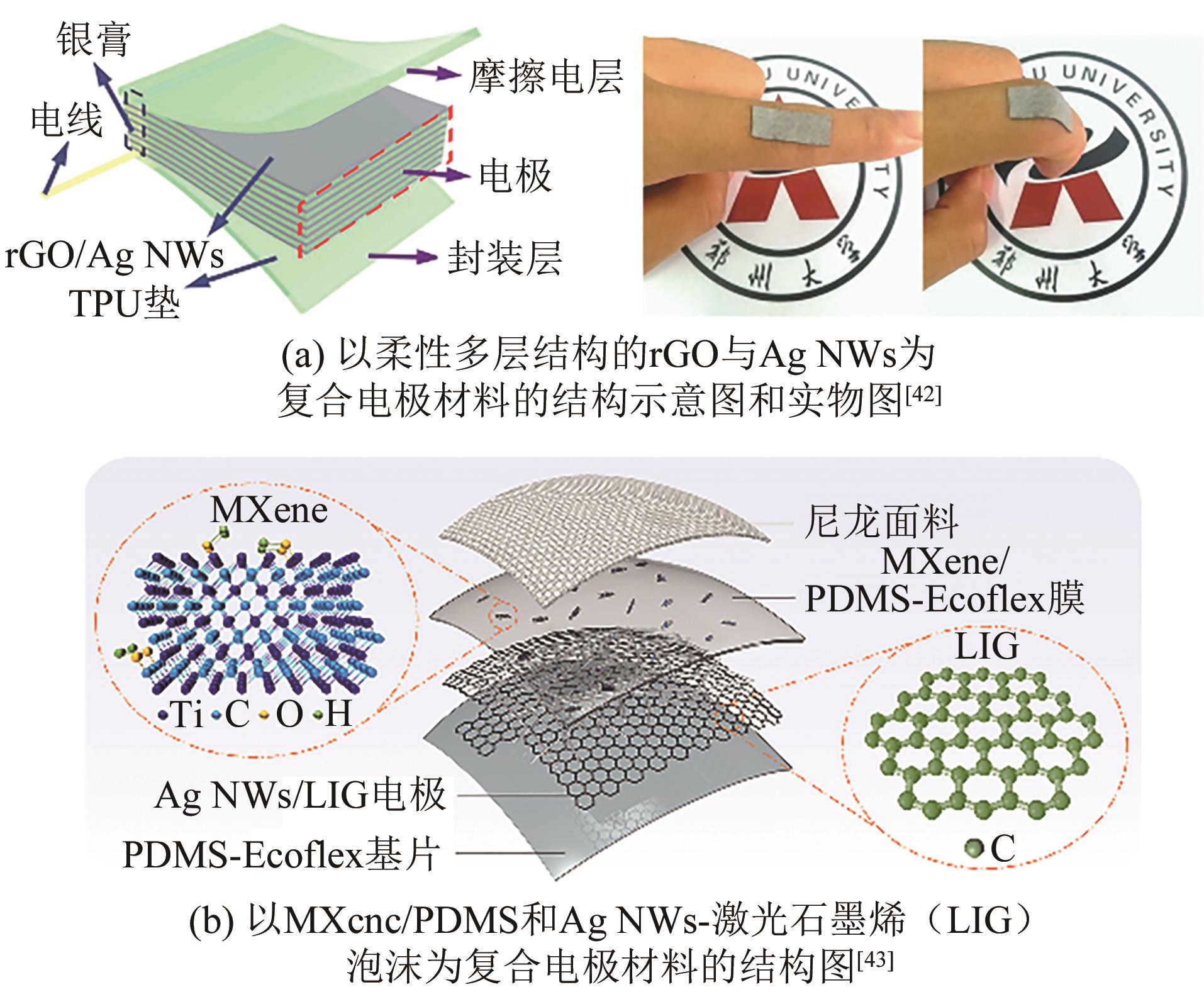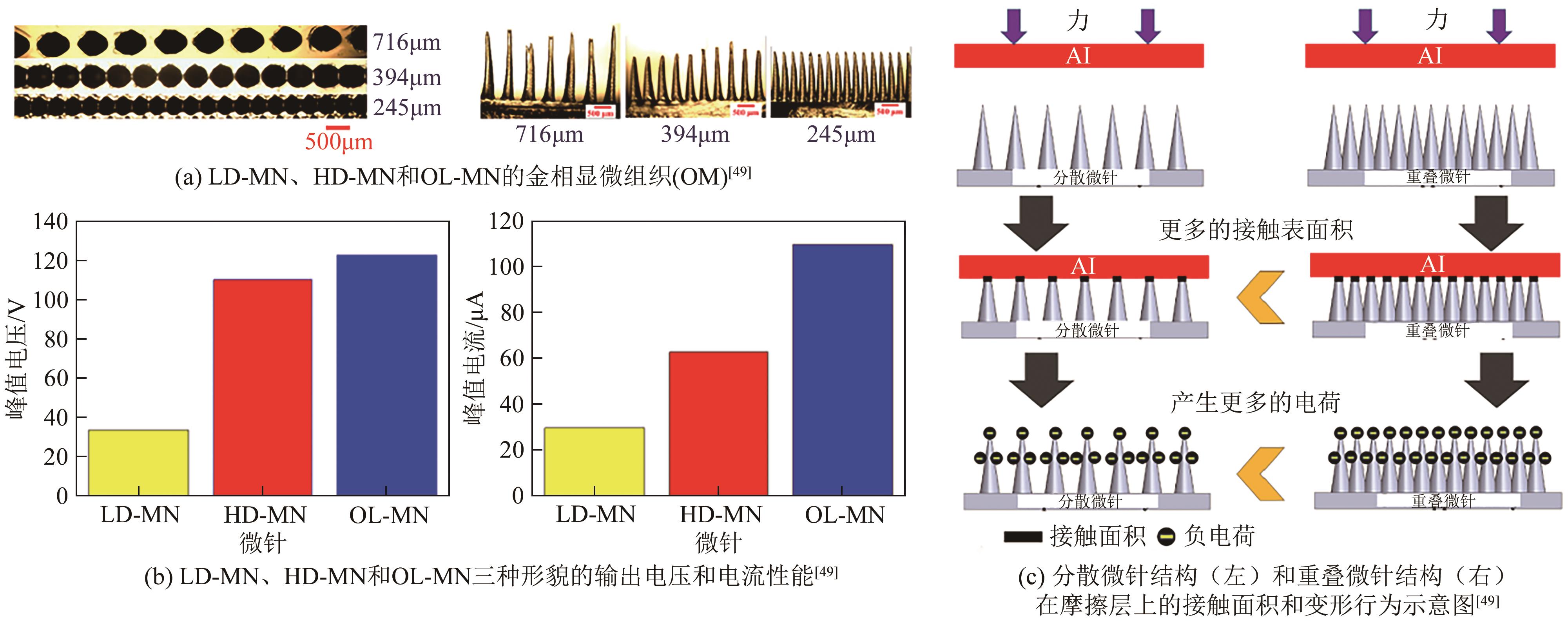化工进展 ›› 2024, Vol. 43 ›› Issue (10): 5601-5611.DOI: 10.16085/j.issn.1000-6613.2023-1690
• 材料科学与技术 • 上一篇
柔性摩擦电压力传感器结构设计及应用的研究进展
王荟琪1( ), 张会1,2,3,4(
), 张会1,2,3,4( ), 李亚鹏1,2,3,4(
), 李亚鹏1,2,3,4( ), 冯伟1, 武泽园1, 李仕琳1, 杨旋1, 张建华1
), 冯伟1, 武泽园1, 李仕琳1, 杨旋1, 张建华1
- 1.陕西理工大学材料科学与工程学院,陕西 汉中 723001
2.起落架及飞机结构件加工检测陕西省高校工程研究中心,陕西 汉中 723000
3.陕西省“四主体一联合”飞机起落架先进制造及航空零组件性能测试校企联合研究中心,陕西 汉中 723000
4.陕西高校青年创新团队,陕西 汉中 723000
-
收稿日期:2023-09-25修回日期:2023-12-15出版日期:2024-10-15发布日期:2024-10-29 -
通讯作者:张会,李亚鹏 -
作者简介:王荟琪(1998—),女,硕士研究生,研究方向为功能材料的开发与应用。E-mail:whq1998113@163.com。 -
基金资助:陕西省科技厅工业攻关项目(2024GX-YBXM-376);陕西省秦创原“科学家+工程师”队伍项目(2022KXJ-139);陕西省重点产业链项目(2023-ZDLGY-28);陕西省重点研发计划(2022GY-416)
Research progress of structure design and application of flexible triboelectric pressure sensor
WANG Huiqi1( ), ZHANG Hui1,2,3,4(
), ZHANG Hui1,2,3,4( ), LI Yapeng1,2,3,4(
), LI Yapeng1,2,3,4( ), FENG Wei1, WU Zeyuan1, LI Shilin1, YANG Xuan1, ZHANG Jianhua1
), FENG Wei1, WU Zeyuan1, LI Shilin1, YANG Xuan1, ZHANG Jianhua1
- 1.School of Materials Science and Engineering, Shaanxi University of Technology, Hanzhong 723000, Shaanxi, China
2.Engineering Research Center of Manufacturing and Testing for Landing Gear and Aircraft Structural Parts, Hanzhong 723000, Shaanxi, China
3.Research Center of Aircraft Landing Gear Advanced Manufacturing and Aviation Component Performance Test, Shaanxi Province, Hanzhong 723000, Shaanxi, China
4.The Youth Innovation Team of Shaanxi Universities-Material Processing and Component Performance Testing of Aviation, Hanzhong 723000, Shaanxi, China
-
Received:2023-09-25Revised:2023-12-15Online:2024-10-15Published:2024-10-29 -
Contact:ZHANG Hui, LI Yapeng
摘要:
伴随着人工智能化和可持续能源的发展,柔性摩擦电压力传感器凭借轻量化、小尺寸、低能耗、可拉伸以及优异的电气性能等优点在人体运动及健康监测、智能医疗和人机交互等领域显现出强大的发展潜力。但是截至目前,对于柔性摩擦电压力传感器如何通过结构设计获得高指标性能是目前所面临的关键问题。在未来,柔性摩擦电压力传感器会更注重微结构的设计与传感性能的构建。因此,本文基于柔性摩擦电压力传感器的原理,总结并概述了影响柔性摩擦电压力传感器性能的核心因素,即核心元件材料的选择和结构设计。同时重点阐述了三种不同结构设计柔性摩擦电压力传感器的工作方式,揭示了不同类型的结构对其性能的影响。此外,还总结了该类传感器目前的应用领域及存在的瓶颈问题。最后指出了柔性摩擦电压力传感器未来的发展趋势,新型材料和结构设计有机结合将有利于进一步推进柔性摩擦电压力传感器实现量产化的市场需求。
中图分类号:
引用本文
王荟琪, 张会, 李亚鹏, 冯伟, 武泽园, 李仕琳, 杨旋, 张建华. 柔性摩擦电压力传感器结构设计及应用的研究进展[J]. 化工进展, 2024, 43(10): 5601-5611.
WANG Huiqi, ZHANG Hui, LI Yapeng, FENG Wei, WU Zeyuan, LI Shilin, YANG Xuan, ZHANG Jianhua. Research progress of structure design and application of flexible triboelectric pressure sensor[J]. Chemical Industry and Engineering Progress, 2024, 43(10): 5601-5611.
| 电极材料 | 检测区间/kPa | 最大灵敏度 | 拉伸性/% | 可重复性/周期 | 参考文献 |
|---|---|---|---|---|---|
| Ag NWs | 6.65~19.21 | 0.3086V/kPa | 144.6 | 1200 | [ |
| Au NWs | 40~100 | 0.0065V/kPa | 115 | 5000 | [ |
| PEDOT-PSS | 2~60 | 0.08/kPa | 100 | — | [ |
| STCH | 0~16.67 | — | 850 | 3000 | [ |
| CNTs | 0~650 | 0.0479/kPa | — | 2000 | [ |
| Gr | 1.3~101.7 | 0.274V/kPa | — | 2000 | [ |
| MXene/SEBS | 4~100 | 6.03/kPa | 34 | 10000 | [ |
| rGO/Ag NWs | 0~5 | 78.4/kPa | 200 | 10000 | [ |
表1 常用电极材料的TPSs性能
| 电极材料 | 检测区间/kPa | 最大灵敏度 | 拉伸性/% | 可重复性/周期 | 参考文献 |
|---|---|---|---|---|---|
| Ag NWs | 6.65~19.21 | 0.3086V/kPa | 144.6 | 1200 | [ |
| Au NWs | 40~100 | 0.0065V/kPa | 115 | 5000 | [ |
| PEDOT-PSS | 2~60 | 0.08/kPa | 100 | — | [ |
| STCH | 0~16.67 | — | 850 | 3000 | [ |
| CNTs | 0~650 | 0.0479/kPa | — | 2000 | [ |
| Gr | 1.3~101.7 | 0.274V/kPa | — | 2000 | [ |
| MXene/SEBS | 4~100 | 6.03/kPa | 34 | 10000 | [ |
| rGO/Ag NWs | 0~5 | 78.4/kPa | 200 | 10000 | [ |
| 1 | WANG Kang, ZHANG Yangyang, LI Hankun, et al. Friction for flexible pressure sensors and arrays on polymers[J]. Journal of Science: Advanced Materials and Devices, 2022, 7(4): 100512. |
| 2 | BIJENDER, KUMAR Ashok. Recent progress in the fabrication and applications of flexible capacitive and resistive pressure sensors[J]. Sensors and Actuators A: Physical, 2022, 344: 113770. |
| 3 | EKIZ Deniz, Yekta Said CAN, DARDAĞAN Yağmur Ceren, et al. End-to-end deep multi-modal physiological authentication with smartbands[J]. IEEE Sensors Journal, 2021, 21(13): 14977-14986. |
| 4 | NGUYEN Nhan Duc, TRUONG Phuc Huu, JEONG Gu-Min. Daily wrist activity classification using a smart band[J]. Physiological Measurement, 2017, 38(9): L10-L16. |
| 5 | HE Ke, LIU Zhiyuan, WAN Changjin, et al. An on-skin electrode with anti-epidermal-surface-lipid function based on a zwitterionic polymer brush[J]. Advanced Materials, 2020, 32(24): e2001130. |
| 6 | LIN Qiupeng, HUANG Jun, YANG Junlong, et al. Highly sensitive flexible iontronic pressure sensor for fingertip pulse monitoring[J]. Advanced Healthcare Materials, 2020, 9(17): e2001023. |
| 7 | WANG Chunfeng, DONG Lin, PENG Dengfeng, et al. Tactile sensors for advanced intelligent systems[J]. Advanced Intelligent Systems, 2019, 1(8): 1900090. |
| 8 | PARK Jonghwa, LEE Youngoh, HONG Jaehyung, et al. Giant tunneling piezoresistance of composite elastomers with interlocked microdome arrays for ultrasensitive and multimodal electronic skins[J]. ACS Nano, 2014, 8(5): 4689-4697. |
| 9 | CHEN Shuai, JIANG Kai, LOU Zheng, et al. Recent developments in graphene-based tactile sensors and E-skins[J]. Advanced Materials Technologies, 2018, 3(2): 1700248. |
| 10 | PANG Changhyun, LEE Gil-Yong, KIM Tae-il, et al. A flexible and highly sensitive strain-gauge sensor using reversible interlocking of nanofibres[J]. Nature Materials, 2012, 11(9): 795-801. |
| 11 | FAN Fengru, LIN Long, ZHU Guang, et al. Transparent triboelectric nanogenerators and self-powered pressure sensors based on micropatterned plastic films[J]. Nano Letters, 2012, 12(6): 3109-3114. |
| 12 | SHI Qiongfeng, HE Tianyiyi, LEE Chengkuo. More than energy harvesting - Combining triboelectric nanogenerator and flexible electronics technology for enabling novel micro-/ nano-systems[J]. Nano Energy, 2019, 57: 851-871. |
| 13 | WANG Sihong, LIN Long, WANG Zhong lin. Nanoscale triboelectric-effect-enabled energy conversion for sustainably powering portable electronics[J]. Nano Letters, 2012, 12(12): 6339-6346. |
| 14 | LI Xunjia, JIANG Chengmei, ZHAO Fengnian, et al. Fully stretchable triboelectric nanogenerator for energy harvesting and self-powered sensing[J]. Nano Energy, 2019, 61: 78-85. |
| 15 | LV Pinlei, SHI Lei, FAN Chengyu, et al. Hydrophobic ionic liquid gel-based triboelectric nanogenerator: Next generation of ultrastable, flexible, and transparent power sources for sustainable electronics[J]. ACS Applied Materials & Interfaces, 2020, 12(13): 15012-15022. |
| 16 | YE Chao, XU Quanfu, REN Jing, et al. Violin string inspired core-sheath silk/steel yarns for wearable triboelectric nanogenerator applications[J]. Advanced Fiber Materials, 2020, 2(1): 24-33. |
| 17 | GUO Hang, WAN Ji, WU Hanxiang, et al. Self-powered multifunctional electronic skin for a smart anti-counterfeiting signature system[J]. ACS Applied Materials & Interfaces, 2020, 12(19): 22357-22364. |
| 18 | LU Zhuo, ZHU Yongsheng, JIA Changjun, et al. A self-powered portable flexible sensor of monitoring speed skating techniques[J]. Biosensors, 2021, 11(4): 108. |
| 19 | Sumin LIM, Donghee SON, KIM Jaemin, et al. Transparent and stretchable interactive human machine interface based on patterned graphene heterostructures[J]. Advanced Functional Materials, 2015, 25(3): 375-383. |
| 20 | CHOI Seunghoon, YOON Kukro, LEE Sanggeun, et al. Spray coating technologies: Conductive hierarchical hairy fibers for highly sensitive, stretchable, and water-resistant multimodal gesture-distinguishable sensor, VR applications[J]. Advanced Functional Materials, 2019, 29(50): 1970344. |
| 21 | 李凤超, 孔振, 吴锦华, 等. 柔性压阻式压力传感器的研究进展[J]. 物理学报, 2021, 70(10): 7-24. |
| LI Fengchao, KONG Zhen, WU Jinhua, et al. Advances in flexible piezoresistive pressure sensor[J]. Acta Physica Sinica, 2021, 70(10): 7-24. | |
| 22 | 汤桂君, 殷柯柯, 原会雨. 纳米材料在柔性压阻式压力传感器中的研究进展[J]. 复合材料学报, 2023, 40(7): 3722-3737. |
| TANG Guijun, YIN Keke, YUAN Huiyu. Research progress of nanomaterials in flexible piezoresistive pressure sensors[J]. Acta Materiae Compositae Sinica, 2023, 40(7): 3722-3737. | |
| 23 | ZHENG Qiang, SHI Bojing, LI Zhou, et al. Recent progress on piezoelectric and triboelectric energy harvesters in biomedical systems[J]. Advanced Science, 2017, 4(7): 1700029. |
| 24 | FAN Fengru, TIAN Zhongqun, WANG Zhonglin. Flexible triboelectric generator[J]. Nano Energy, 2012, 1(2): 328-334. |
| 25 | LEI Hao, CHEN Yunfeng, GAO Zhenqiu, et al. Advances in self-powered triboelectric pressure sensors[J]. Journal of Materials Chemistry A, 2021, 9(36): 20100-20130. |
| 26 | GUO Linan, WU Guitao, WANG Qunyi, et al. Advances in triboelectric pressure sensors[J]. Sensors and Actuators A: Physical, 2023, 355: 114331. |
| 27 | SONG Weixing, GAN Baoheng, JIANG Tao, et al. Nanopillar arrayed triboelectric nanogenerator as a self-powered sensitive sensor for a sleep monitoring system[J]. ACS Nano, 2016, 10(8): 8097-8103. |
| 28 | WANG Zhong lin, LIN Long, CHEN Jun, et al. Theoretical modeling of triboelectric nanogenerators[M]//Triboelectric Nanogenerators. Cham: Springer International Publishing, 2016: 155-183. |
| 29 | LIU Yiming, ZHAO Ling, AVILA Raduel, et al. Epidermal electronics for respiration monitoring via thermo-sensitive measuring[J]. Materials Today Physics, 2020, 13: 100199. |
| 30 | KIM Daewon, JEON Seung-Bae, KIM Ju Young, et al. High-performance nanopattern triboelectric generator by block copolymer lithography[J]. Nano Energy, 2015, 12: 331-338. |
| 31 | SHI Yapeng, WEI Xuelian, WANG Kaimeng, et al. Integrated all-fiber electronic skin toward self-powered sensing sports systems[J]. ACS Applied Materials & Interfaces, 2021, 13(42): 50329-50337. |
| 32 | AN Tiance, ANAYA David Vera, GONG Shu, et al. Self-powered gold nanowire tattoo triboelectric sensors for soft wearable human-machine interface[J]. Nano Energy, 2020, 77: 105295. |
| 33 | WEN Zhen, YANG Yanqin, SUN Na, et al. A wrinkled PEDOT: PSS film based stretchable and transparent triboelectric nanogenerator for wearable energy harvesters and active motion sensors[J]. Advanced Functional Materials, 2018, 28(37): 1803684. |
| 34 | LIU Yiming, WONG Tsz Hung, HUANG Xingcan, et al. Skin-integrated, stretchable, transparent triboelectric nanogenerators based on ion-conducting hydrogel for energy harvesting and tactile sensing[J]. Nano Energy, 2022, 99: 107442. |
| 35 | CHENG Kuan, WALLAERT Samuel, ARDEBILI Haleh, et al. Advanced triboelectric nanogenerators based on low-dimension carbon materials: A review[J]. Carbon, 2022, 194: 81-103. |
| 36 | LIU Mengyang, HANG Chengzhou, ZHAO Xuefeng, et al. Advance on flexible pressure sensors based on metal and carbonaceous nanomaterial[J]. Nano Energy, 2021, 87: 106181. |
| 37 | CAO Ran, PU Xianjie, DU Xinyu, et al. Screen-printed washable electronic textiles as self-powered touch/gesture tribo-sensors for intelligent human-machine interaction[J]. ACS Nano, 2018, 12(6): 5190-5196. |
| 38 | LEE Yongjun, KIM Jejung, JANG Bongkyun, et al. Graphene-based stretchable/wearable self-powered touch sensor[J]. Nano Energy, 2019, 62: 259-267. |
| 39 | DONG Yongchang, MALLINENI Sai Sunil Kumar, MALESKI Kathleen, et al. Metallic MXenes: A new family of materials for flexible triboelectric nanogenerators[J]. Nano Energy, 2018, 44: 103-110. |
| 40 | FAN Jiacheng, YUAN Mengmeng, WANG Libo, et al. MXene supported by cotton fabric as electrode layer of triboelectric nanogenerators for flexible sensors[J]. Nano Energy, 2023, 105: 107973. |
| 41 | LUO Xiongxin, ZHU Laipan, WANG Yichi, et al. A flexible multifunctional triboelectric nanogenerator based on MXene/PVA hydrogel[J]. Advanced Functional Materials, 2021, 31(38): 2104928. |
| 42 | ZHOU Kangkang, ZHAO Yi, SUN Xiupeng, et al. Ultra-stretchable triboelectric nanogenerator as high-sensitive and self-powered electronic skins for energy harvesting and tactile sensing[J]. Nano Energy, 2020, 70: 104546. |
| 43 | YANG Li, LIU Chaosai, YUAN Wenjing, et al. Fully stretchable, porous mxene-graphene foam nanocomposites for energy harvesting and self-powered sensing[J]. Nano Energy, 2022, 103: 107807. |
| 44 | ZHU Guang, YANG Wei qing, ZHANG Tiejun, et al. Self-powered, ultrasensitive, flexible tactile sensors based on contact electrification[J]. Nano Letters, 2014, 14(6): 3208-3213. |
| 45 | LI Tong, PAN Peng, YANG Zhengchun, et al. Research on PDMS TENG of laser etch 3D structure[J]. Journal of Materials Science, 2022, 57(12): 6723-6733. |
| 46 | ZHOU Qitao, PARK Jun Gyu, KIM Kyeong Nam, et al. Transparent-flexible-multimodal triboelectric nanogenerators for mechanical energy harvesting and self-powered sensor applications[J]. Nano Energy, 2018, 48: 471-480. |
| 47 | FENG Hanfang, LI Huayang, XU Jin, et al. Triboelectric nanogenerator based on direct image lithography and surface fluorination for biomechanical energy harvesting and self-powered sterilization[J]. Nano Energy, 2022, 98: 107279. |
| 48 | TCHO Il-Woong, KIM Weon-Guk, JEON Seung-Bae, et al. Surface structural analysis of a friction layer for a triboelectric nanogenerator[J]. Nano Energy, 2017, 42: 34-42. |
| 49 | CHUNG Chen-Kuei, KE Kai-Hong. High contact surface area enhanced Al/PDMS triboelectric nanogenerator using novel overlapped microneedle arrays and its application to lighting and self-powered devices[J]. Applied Surface Science, 2020, 508: 145310. |
| 50 | KE Kaihong, CHUNG Chen-Kuei. High-performance Al/PDMS TENG with novel complex morphology of two-height microneedles array for high-sensitivity force-sensor and self-powered application[J]. Small, 2020, 16(35): 2001209. |
| 51 | MAHARJAN Pukar, BHATTA Trilochan, SALAUDDIN Md, et al. A human skin-inspired self-powered flex sensor with thermally embossed microstructured triboelectric layers for sign language interpretation[J]. Nano Energy, 2020, 76: 105071. |
| 52 | ZHANG Honghao, ZHANG Ping, DENG Lu, et al. Three-dimensional polypyrrole nanoarrays for wearable triboelectric nanogenerators[J]. ACS Applied Nano Materials, 2022, 5(8): 11219-11228. |
| 53 | LIU Liqiang, YANG Xiya, ZHAO Leilei, et al. Nanowrinkle-patterned flexible woven triboelectric nanogenerator toward self-powered wearable electronics[J]. Nano Energy, 2020, 73: 104797. |
| 54 | WU Mengge, GAO Zhan, YAO Kuanming, et al. Thin, soft, skin-integrated foam-based triboelectric nanogenerators for tactile sensing and energy harvesting[J]. Materials Today Energy, 2021, 20: 100657. |
| 55 | VALLEM Veenasri, ROOSA Erin, LEDINH Tyler, et al. A soft variable-area electrical-double-layer energy harvester[J]. Advanced Materials, 2021, 33(43): 2103142. |
| 56 | WANG Xingling, SHI Yuxiang, YANG Peng, et al. Fish-wearable data snooping platform for underwater energy harvesting and fish behavior monitoring[J]. Small, 2022, 18(10): e2107232. |
| 57 | OUYANG Yue, WANG Xuechuan, LIU Xinhua, et al. Spider-web and ant-tentacle doubly bio-inspired multifunctional self-powered electronic skin with hierarchical nanostructure[J]. Advanced Science, 2021, 8(15): 2004377. |
| 58 | YEH Cheng, Fucheng KAO, WEI Pohan, et al. Bioinspired shark skin-based liquid metal triboelectric nanogenerator for self-powered gait analysis and long-term rehabilitation monitoring[J]. Nano Energy, 2022, 104: 107852. |
| 59 | ZHU Miaomiao, WANG Yabing, LOU Mengna, et al. Bioinspired transparent and antibacterial electronic skin for sensitive tactile sensing[J]. Nano Energy, 2021, 81: 105669. |
| 60 | JI Bing, ZHOU Qian, HU Bin, et al. Bio-inspired hybrid dielectric for capacitive and triboelectric tactile sensors with high sensitivity and ultrawide linearity range[J]. Advanced Materials, 2021, 33(27): 2100859. |
| 61 | MENG Keyu, ZHAO Shenlong, ZHOU Yihao. A wireless textile-based sensor system for self-powered personalized health care[J]. Matter, 2020, 2(4): 896-907. |
| 62 | BABU Anand, MALIK Pinki, Nityananda DAS, et al. Surface potential tuned single active material comprised triboelectric nanogenerator for a high performance voice recognition sensor[J]. Small (Weinheim an Der Bergstrasse, Germany), 2022, 18(22): e2201331. |
| 63 | LI Hui, SUN Yannan, SU Yujun, et al. Multi-scale metal mesh based triboelectric nanogenerator for mechanical energy harvesting and respiratory monitoring[J]. Nano Energy, 2021, 89: 106423. |
| 64 | NIU Qianqian, HUANG Li, Shasha LYU, et al. Pulse-driven bio-triboelectric nanogenerator based on silk nanoribbons[J]. Nano Energy, 2020, 74: 104837. |
| 65 | LOU Mengna, ABDALLA Ibrahim, ZHU Miaomiao, et al. Hierarchically rough structured and self-powered pressure sensor textile for motion sensing and pulse monitoring[J]. ACS Applied Materials & Interfaces, 2020, 12(1): 1597-1605. |
| 66 | HUO Xiaomin. A self-powered triboelectric pressure sensor for basketball training monitoring[J]. Materials Letters, 2022, 320: 132339. |
| 67 | SUN Ping, CAI Nixin, ZHONG Xiaodi, et al. Facile monitoring for human motion on fireground by using MiEs-TENG sensor[J]. Nano Energy, 2021, 89: 106492. |
| 68 | LU Xiao, ZHENG Li, ZHANG Haodong, et al. Stretchable, transparent triboelectric nanogenerator as a highly sensitive self-powered sensor for driver fatigue and distraction monitoring[J]. Nano Energy, 2020, 78: 105359. |
| 69 | YANG Jin, AN Jie, SUN Yanshuo, et al. Transparent self-powered triboelectric sensor based on PVA/PA hydrogel for promoting human-machine interaction in nursing and patient safety[J]. Nano Energy, 2022, 97: 107199. |
| 70 | QU Xuecheng, LIU Zhuo, TAN Puchuan, et al. Artificial tactile perception smart finger for material identification based on triboelectric sensing[J]. Science Advances, 2022, 8(31): eabq2521. |
| [1] | 唐春霞, 李萌, 王玉玺, 宗永忠, 付少海. Cr(Ⅵ)去除用功能化纤维素纳米材料的结构设计研究进展[J]. 化工进展, 2023, 42(2): 585-594. |
| [2] | 徐娜, 王国栋, 陶亚楠. 柔性可穿戴压阻式压力传感器研究进展[J]. 化工进展, 2023, 42(10): 5259-5271. |
| [3] | 边宇, 张百超, 郑红. 多级孔COFs材料的设计、合成及应用[J]. 化工进展, 2022, 41(9): 4866-4883. |
| [4] | 岳孟, 郑琼, 阎景旺, 张华民, 李先锋. 液流电池流场结构设计与优化研究进展[J]. 化工进展, 2021, 40(9): 4853-4868. |
| [5] | 王学科, 沈义伟, 赵洪滨, 曹岭, 陈山, 贾彩, 谢晓峰. 旋涡式氢气循环泵的设计及性能分析[J]. 化工进展, 2020, 39(S2): 89-96. |
| [6] | 倪永涛, 赵钦新, 桂雍, 王云刚, 邵怀爽. 两级低压引射器的结构设计与数值分析[J]. 化工进展, 2020, 39(S1): 69-76. |
| [7] | 许晓芝, 李彪, 施凯强, 董思源, 靳祖超, 韩景宾. LDHs基气体阻隔薄膜材料的研究进展[J]. 化工进展, 2020, 39(6): 2177-2186. |
| [8] | 裴强,丁爱祥,杨明丽,徐果,徐文豪. 氢键型超分子聚合物[J]. 化工进展, 2020, 39(1): 233-249. |
| [9] | 覃发梅, 邱学青, 孙川, 丁子先, 方志强. 纳米纤维素去除水体系重金属离子的研究进展[J]. 化工进展, 2019, 38(07): 3390-3401. |
| [10] | 于宾, 赵晓明, 孙天. 基于纤维取向的纳米纤维滤料设计及其性能[J]. 化工进展, 2018, 37(10): 3966-3973. |
| [11] | 尚阳, 王跃社. 单喷嘴低压引射器的结构设计与数值分析[J]. 化工进展, 2017, 36(S1): 107-114. |
| [12] | 严涛, 刘玉丰, 刘丰. 液化天然气(LNG)接收站节能再冷凝器的研究与设计[J]. 化工进展, 2015, 34(s1): 51-54. |
| [13] | 胡琼, 孙见君, 涂桥安, 马晨波, 何斌辉, 刘平. 剖分式机械密封技术研究现状及关键问题探讨[J]. 化工进展, 2015, 34(05): 1207-1214. |
| 阅读次数 | ||||||
|
全文 |
|
|||||
|
摘要 |
|
|||||








